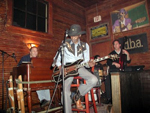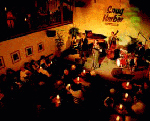The state of California and the city of New Orleans are both places where ethnic diversity provides a strong sense of cultural variety and blending. A multi-textured backdrop which makes certain areas in California such San Diego, Los Angeles and San Fransisco complex and vibrant with different types of people living together in a cosmopolitan manner, bringing different food, languages and traditions into the mix and making these cities unique. California is the most popular destination for immigrants with about half of all immigrants to the United States residing in California. Likewise, New Orleans has seen an influx of immigrants over the course of its existence that make it a unique melting pot as well.
 |
| Chinatown San Francisco |
 |
| Olvera Street Los Angeles |
New Orleans, while originally settled by the French, has become home to a large number of ethnicity's. It is a place where Africans, both slave and free, and Native Americans shared their cultures and intermingled with European settlers. Encouraged by the French government, this strategy for producing a durable culture in a difficult place marked New Orleans as different and special from its inception and continues to distinguish New Orleans today.
New Orleans, like early settlements along the Massachusetts Bay and Chesapeake Bay, served as a distinctive cultural gateway to North America where people from Europe and Africa initially intertwined their lives and customs with those of the native inhabitants of the New World. The resulting way of life differed dramatically from the culture that came out of the English colonies of

North America. After its founding, more French continued to come to New Orleans, as did Spaniards and Cubans. The largest waves of immigrants came from Ireland and Germany. In certain neighborhoods, their descendants dialects make visitors feel like they are in neighborhoods in Brooklyn or the southside of Chicago. From 1820 to 1870, the Irish and Germans made New Orleans one of the main immigrant ports of the nation. Just before the beginning of the 20th century, thousands of Sicilians came into New Orleans and added even more complexity to its population. The French, the blacks, the Spanish, the Germans, the Irish and the Italians constitute the largest ethnic groups to settle in New Orleans.


There are a number of smaller immigrant groups in the last century and in the present one which add to the diversity of the city, they are: the Jews, the Greeks, the Yugoslavs (Dalmatians, Slavonians), the "Arbreshe" or Albano-Sicilians, the Lebanese, the Filipinos, and the Chinese. More recent arrivals are the Koreans and Vietnamese, the Japanese and people from India.
A new cultural addition to New Orleans has come in the wake of Hurricane Katrina. There has been a huge increase in the number of Latinos moving to the city. Tens of thousands of Latinos moved to the city,which had never had a sizable Hispanic community. Since Katrina, whole neighborhoods have been transformed by the new Latino residents and businesses. In Kenner, near the city's airport, Hispanics now make up 22 percent of the population, up from 14 percent a decade ago.
New Orleans unique identity needs more explanation than a variant colonial past and a wildly diverse population. After all, California once belonged to Mexico, and today it draws more domestic and foreign transplants than any other place in the nation. Yet visitors seldom consider it "foreign". On the contrary, California has come to define what is quintessentially American. On the other hand, New Orleans has remained an American province with a vibrant way of life. What the cities citizens celebrate is less the Old World cultures of their ancestors, and more the new way of life that evolved in New Orleans. New Orleans is a place in the United States that feels like no other.
Photo Sources: Google Images
Information Sources:
Hardwick, Shelley & Holtgrieve. The Geography of North America: Environment/Culture/Economy .









